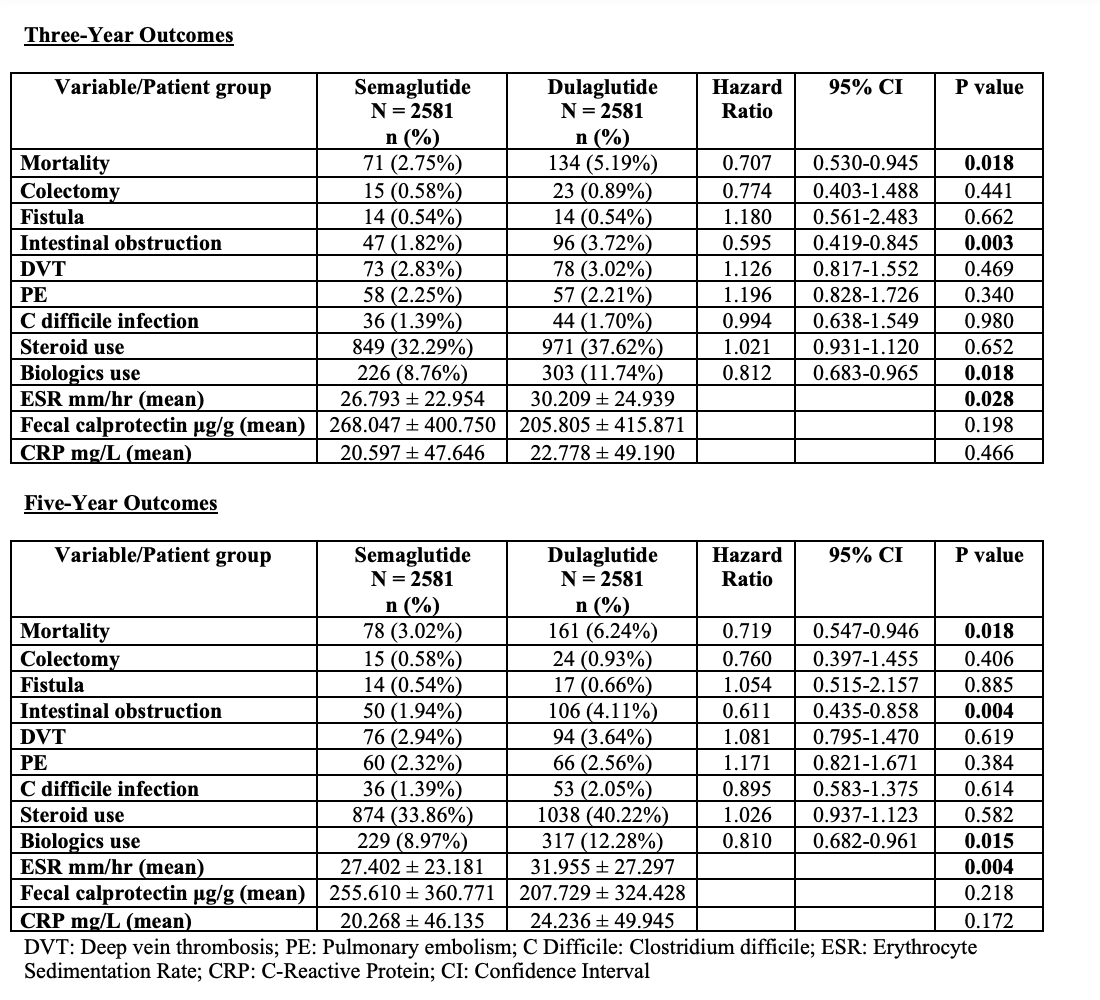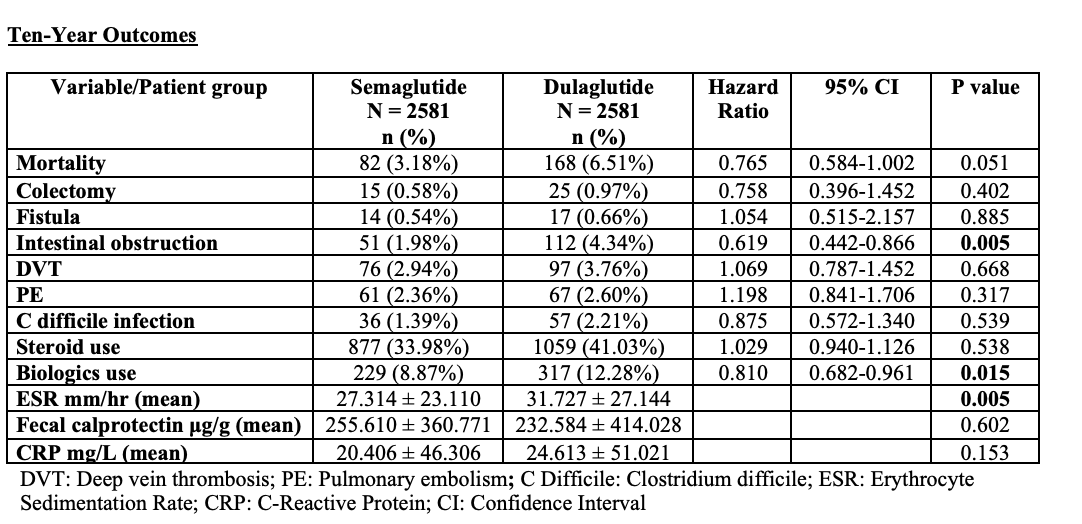Sunday Poster Session
Category: IBD
P1164 - GLP-1 Agonists in Inflammatory Bowel Disease: Does the Choice Between Semaglutide and Dulaglutide Matter?
Sunday, October 26, 2025
3:30 PM - 7:00 PM PDT
Location: Exhibit Hall
- AM
Aun Muhammad, MD
University of Mississippi Medical Center
Flowood, MS
Presenting Author(s)
Aun Muhammad, MD1, Zehra Naseem, MD2, Elizabeth Paine, MD3
1University of Mississippi Medical Center, Flowood, MS; 2Cleveland Clinic, Cleveland, OH; 3G.V. (Sonny) Montgomery VA Medical Center, University of Mississippi Medical Center, Madison, MS
Introduction: The prevalence of obesity is rising worldwide with a parallel rise in inflammatory bowel disease (IBD). Studies on impact of obesity on IBD are conflicting, some suggest increased adverse events in IBD population with obesity and improved outcomes in IBD patients with obesity undergoing treatment with glucagon-like peptide (GLP-1) agonists. However, there has been no comparison of individual GLP-1 agonists on outcomes of IBD. We compared 3-, 5-, and 10-year outcomes of patients with IBD with co-existing obesity on Semaglutide vs Dulaglutide.
Methods: We performed a retrospective cohort study using the TrinNetX database, a comprehensive multi-institutional dataset. The study included patients aged ≥ 18 years and BMI ≥30 kg/m2 with a diagnosis of IBD (Crohn’s disease and Ulcerative colitis) from 1/1/2014 to 4/30/2025. Patients were categorized based on whether they received only Semaglutide or only Dulaglutide any time after the diagnosis of IBD. The primary aim was to assess outcomes of IBD at 3, 5, and 10 years. One to one propensity score matching was applied for age, gender, race, tobacco use, alcohol use, comorbidities, BMI, IBD medications (mesalamine, steroids, biologics), and fecal calprotectin.
Results: After propensity matching, a total of 2581 patients were included in each group. Semaglutide was associated with a lower 3-, 5-, and 10-year risk of intestinal obstruction and use of biologics than Dulaglutide. Additionally, Semaglutide was associated with a lower risk of mortality than Dulaglutide over 3 and 5 years. On the other hand, risk of colectomy, fistula formation, deep venous thrombosis, pulmonary embolism, Clostridium difficile infection, and use of systemic steroids over 3-, 5-, and 10- years was similar between the two groups. Semaglutide was also associated with lower mean levels of Erythrocyte Sedimentation Rate over 3-, 5-, and 10- years, while there was no significant difference in mean levels of fecal calprotectin and serum C-Reactive Protein over this time period (Table 1a and 1b).
Discussion: This study provides evidence that Semaglutide may offer superior long-term outcomes in IBD patients with obesity compared to Dulaglutide, particularly in reducing intestinal obstruction, biologic use, and mortality over 3 and 5 years. The findings highlight Semaglutide’s potential as a dual-purpose agent for managing both metabolic disease and IBD-related inflammation. Further prospective studies are warranted to validate these findings and explore the underlying mechanisms.

Figure: Three-year and five-year outcomes of patients with inflammatory bowel disease with co-existing obesity on Semaglutide vs Dulaglutide

Figure: Ten-year outcomes of patients with inflammatory bowel disease with co-existing obesity on Semaglutide vs Dulaglutide
Disclosures:
Aun Muhammad indicated no relevant financial relationships.
Zehra Naseem indicated no relevant financial relationships.
Elizabeth Paine indicated no relevant financial relationships.
Aun Muhammad, MD1, Zehra Naseem, MD2, Elizabeth Paine, MD3. P1164 - GLP-1 Agonists in Inflammatory Bowel Disease: Does the Choice Between Semaglutide and Dulaglutide Matter?, ACG 2025 Annual Scientific Meeting Abstracts. Phoenix, AZ: American College of Gastroenterology.
1University of Mississippi Medical Center, Flowood, MS; 2Cleveland Clinic, Cleveland, OH; 3G.V. (Sonny) Montgomery VA Medical Center, University of Mississippi Medical Center, Madison, MS
Introduction: The prevalence of obesity is rising worldwide with a parallel rise in inflammatory bowel disease (IBD). Studies on impact of obesity on IBD are conflicting, some suggest increased adverse events in IBD population with obesity and improved outcomes in IBD patients with obesity undergoing treatment with glucagon-like peptide (GLP-1) agonists. However, there has been no comparison of individual GLP-1 agonists on outcomes of IBD. We compared 3-, 5-, and 10-year outcomes of patients with IBD with co-existing obesity on Semaglutide vs Dulaglutide.
Methods: We performed a retrospective cohort study using the TrinNetX database, a comprehensive multi-institutional dataset. The study included patients aged ≥ 18 years and BMI ≥30 kg/m2 with a diagnosis of IBD (Crohn’s disease and Ulcerative colitis) from 1/1/2014 to 4/30/2025. Patients were categorized based on whether they received only Semaglutide or only Dulaglutide any time after the diagnosis of IBD. The primary aim was to assess outcomes of IBD at 3, 5, and 10 years. One to one propensity score matching was applied for age, gender, race, tobacco use, alcohol use, comorbidities, BMI, IBD medications (mesalamine, steroids, biologics), and fecal calprotectin.
Results: After propensity matching, a total of 2581 patients were included in each group. Semaglutide was associated with a lower 3-, 5-, and 10-year risk of intestinal obstruction and use of biologics than Dulaglutide. Additionally, Semaglutide was associated with a lower risk of mortality than Dulaglutide over 3 and 5 years. On the other hand, risk of colectomy, fistula formation, deep venous thrombosis, pulmonary embolism, Clostridium difficile infection, and use of systemic steroids over 3-, 5-, and 10- years was similar between the two groups. Semaglutide was also associated with lower mean levels of Erythrocyte Sedimentation Rate over 3-, 5-, and 10- years, while there was no significant difference in mean levels of fecal calprotectin and serum C-Reactive Protein over this time period (Table 1a and 1b).
Discussion: This study provides evidence that Semaglutide may offer superior long-term outcomes in IBD patients with obesity compared to Dulaglutide, particularly in reducing intestinal obstruction, biologic use, and mortality over 3 and 5 years. The findings highlight Semaglutide’s potential as a dual-purpose agent for managing both metabolic disease and IBD-related inflammation. Further prospective studies are warranted to validate these findings and explore the underlying mechanisms.

Figure: Three-year and five-year outcomes of patients with inflammatory bowel disease with co-existing obesity on Semaglutide vs Dulaglutide

Figure: Ten-year outcomes of patients with inflammatory bowel disease with co-existing obesity on Semaglutide vs Dulaglutide
Disclosures:
Aun Muhammad indicated no relevant financial relationships.
Zehra Naseem indicated no relevant financial relationships.
Elizabeth Paine indicated no relevant financial relationships.
Aun Muhammad, MD1, Zehra Naseem, MD2, Elizabeth Paine, MD3. P1164 - GLP-1 Agonists in Inflammatory Bowel Disease: Does the Choice Between Semaglutide and Dulaglutide Matter?, ACG 2025 Annual Scientific Meeting Abstracts. Phoenix, AZ: American College of Gastroenterology.
